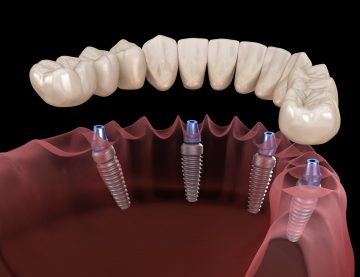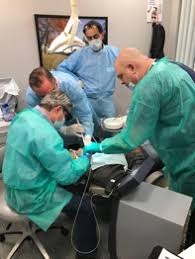Computer-Guided vs. Conventional Methods
 Even up to today, dentists and oral surgeons are trained to place dental implants without computer guidance. But the traditional methods can require greater amounts of time and more invasive procedures. As a result, there can be more recovery time after surgery. Also, some patients may not be candidates for implants when only the conventional methods are used to assess the bone depth and internal structures. In the past, these realities left some patients who need tooth replacement with fewer options.
Even up to today, dentists and oral surgeons are trained to place dental implants without computer guidance. But the traditional methods can require greater amounts of time and more invasive procedures. As a result, there can be more recovery time after surgery. Also, some patients may not be candidates for implants when only the conventional methods are used to assess the bone depth and internal structures. In the past, these realities left some patients who need tooth replacement with fewer options.
Now, when computer-guided implant technology is utilized, more can be known and understood. With the NobelClinician software available at Farber Center for Periodontics & Dental Implants, we can visualize the precise placement of simulated dental implants during a virtual surgery before anything takes place. This advanced technology and equipment also help oral surgeons assess the depth of bone, supporting tissues, and sites where implants can be placed firmly. Thanks to today’s technology, more patients are given the option to choose dental implants rather than bridges or dentures. It is particularly true for patients who need to replace several teeth.
Why are Computer Guided Dental Implants Better?
What are the Advantages?
- Computer-guided dental implant placement lets oral surgeons and dentists make smaller and less invasive incisions, which is more comfortable for patients.
- Less invasive implant procedures allow patients to recover more quickly and comfortably, and with less likelihood of complications.
- The information gathered is extremely accurate, allowing visualization of the implants in position before they are placed. This reduces the risk of complications as well as implant failure.
- Computer-guided implants can be available to patients who have a bone or internal structure issue that would have made them not good candidates for traditional placement methods.
- The advanced technology provides 3D images of the jawbone, root anatomy, soft tissue locations, and bone thickness. Therefore, oral surgeons can place implants with greater confidence and a reduced chance of unexpected events occurring during surgery.
How Does Computer-Guided Implant Surgery Work?
 The procedure starts with the digital imaging of your dental arch. The technology then creates a virtual surgery that shows the new dental implants in 3D images of your jaw anatomy, including bone, nearby teeth, and soft tissue. This image allows oral surgeons and dentists to visualize internal structures so that they can place implants in optional locations thus the name computer-guided implant placement. With the digital images and visualizations, a more accurate treatment plan can be developed before your surgery begins. The results are better, and the chance for complications is lessened.
The procedure starts with the digital imaging of your dental arch. The technology then creates a virtual surgery that shows the new dental implants in 3D images of your jaw anatomy, including bone, nearby teeth, and soft tissue. This image allows oral surgeons and dentists to visualize internal structures so that they can place implants in optional locations thus the name computer-guided implant placement. With the digital images and visualizations, a more accurate treatment plan can be developed before your surgery begins. The results are better, and the chance for complications is lessened.
For you, as a patient, a more advanced dental implant surgery method can mean a less invasive procedure and quicker recovery times. Also, for some people who might have not previously been implant candidates, digital imaging and virtual surgery can bring new opportunities. As you consider options to replace teeth and restore your smile, considering all treatment methods is essential. Seeing a dentist for a thorough exam and a discussion of all possibilities, including their costs, will put you in the best position to make the decision that is right for you.

 Computer-guided dental implant placement is among the newer and more advanced methods for replacing teeth. Many dental professionals today consider it to be among the safer and more accurate oral surgery procedures to replace teeth with implants. Because of its advantages, it continues to gain acceptance among patients. In many cases, computer guidance helps oral surgeons more confidently perform implant placements that might have been more challenging previously therefore expanding the number of people who can qualify for the procedures.
Computer-guided dental implant placement is among the newer and more advanced methods for replacing teeth. Many dental professionals today consider it to be among the safer and more accurate oral surgery procedures to replace teeth with implants. Because of its advantages, it continues to gain acceptance among patients. In many cases, computer guidance helps oral surgeons more confidently perform implant placements that might have been more challenging previously therefore expanding the number of people who can qualify for the procedures.